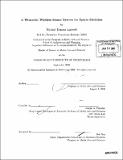A wearable, wireless sensor system for sports medicine
Author(s)
Lapinski, Michael Tomasz
DownloadFull printable version (64.89Mb)
Other Contributors
Massachusetts Institute of Technology. Dept. of Architecture. Program in Media Arts and Sciences.
Advisor
Joseph A. Paradiso.
Terms of use
Metadata
Show full item recordAbstract
This thesis describes a compact, wireless, wearable system that measures, for purposes of biomechanical analysis, signals indicative of forces, torques and other descriptive and evaluative features that the human body undergoes during bursts of extreme physical activity (such as during athletic performance). Standard approaches leverage high speed camera systems, which need significant infrastructure and provide limited update rates and dynamic accuracy, to make these measurements. This project uses 6 degree-of-freedom inertial measurement units worn on various segments of an athlete's body to directly make these dynamic measurements. A combination of low and high G sensors enables sensitivity for slow and fast motion, and the addition of a compass helps in tracking joint angles. Data from the battery-powered nodes is acquired using a custom wireless protocol over an RF link. This data, along with rigorous calibration data, is processed on a PC, with an end product being precise angular velocities and accelerations that can be employed during biomechanical analysis to gain a better understanding of what occurs during activity. The focus of experimentation was baseball pitching and batting at the professional level. Several pitchers and batters were instrumented with the system and data was gathered during several pitches or swings. The data was analyzed, and the results of this analysis are presented in this thesis. The dynamic results are more precise than from other camera based systems and also offer the measurement of metrics that are not available from any other system, providing the opportunity for furthering sports medicine research. System performance and results are evaluated, and ideas for future work and system improvements are presented.
Description
Thesis (S.M.)--Massachusetts Institute of Technology, School of Architecture and Planning, Program in Media Arts and Sciences, 2008. Includes bibliographical references (p. 135-139).
Date issued
2008Department
Program in Media Arts and Sciences (Massachusetts Institute of Technology)Publisher
Massachusetts Institute of Technology
Keywords
Architecture. Program in Media Arts and Sciences.